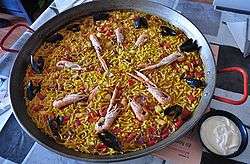Fideuà
Fideuà (dialectal pronunciation of the Valencian word fideuada "large amount of noodles") is a seafood dish originally from the coast of Valencia that is similar to paella, and even more so to arròs a banda, but with noodles instead of rice. Its main ingredients are pasta noodles (usually hollow), fish (rockfish, monkfish, cuttlefish, squid), and shellfish (Squilla mantis, shrimp, crayfish). It is seasoned mainly with lemon.
 | |
| Course | Pasta |
|---|---|
| Place of origin | Spain |
| Region or state | Valencia |
| Main ingredients | Vermicelli, white-fleshed fish, crustaceans |
History
The invention of fideuà is attributed to a picturesque story. Gabriel Rodriguez Pastor, (Gabrielo from a kiosk in the port district of Grau in Gandía), worked as a cook on a boat and Juan Bautista Pascual (Zábalo), was the youngest man on the boat and his assistant. According to Gabriel's family, the boat captain loved rice and the rest of sailors almost never received their full portion of arròs a banda, the dish that the cook usually prepared. Trying to find a solution for the problem, the cook had the idea of using noodles instead of rice to see if the result was a little less appetizing for the captain.
The invention was liked, and fame of the dish spread to harbor restaurants such as the "Pastaora House," where they cooked the first "fideuades." The dish became distinctive and essential in the area.
Characteristics
Just like paella, it is cooked in a special wide and flat frying pan, also called paella, although there are other traditional variants made in a casserole.
Gandia is the birthplace of fideuà, and in this city of La Safor region there is an annual competition where the best cooks try to prepare the best fideuà.
Curiosities
Currently, various skill competitions for chefs are done in preparing fideuà.
.svg.png)